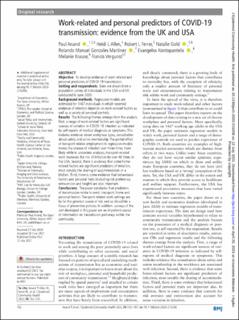| dc.contributor.author | Anand, Paul | |
| dc.contributor.author | Allen, Heidi L | |
| dc.contributor.author | Ferrer, Robert L | |
| dc.contributor.author | Gold, Natalie | |
| dc.contributor.author | Gonzales Martinez, Rolando | |
| dc.contributor.author | Kontopantelis, Evangelos | |
| dc.contributor.author | Krause, Melanie | |
| dc.contributor.author | Vergunst, Francis | |
| dc.date.accessioned | 2023-05-16T09:31:36Z | |
| dc.date.available | 2023-05-16T09:31:36Z | |
| dc.date.created | 2022-05-05T15:19:58Z | |
| dc.date.issued | 2022 | |
| dc.identifier.citation | Anand, P., Allen, H. L., Ferrer, R. L., Gold, N., Gonzales Martinez, R., Kontopantelis, E., Krause, M. & Vergunst, F. (2022). Work-related and personal predictors of COVID-19 transmission: Evidence from the UK and USA. Journal of Epidemiology and Community Health, 76(2), 152-157. doi: | en_US |
| dc.identifier.issn | 0143-005X | |
| dc.identifier.uri | https://hdl.handle.net/11250/3068162 | |
| dc.description.abstract | Objective To develop evidence of work-related and personal predictors of COVID-19 transmission. Setting and respondents Data are drawn from a population survey of individuals in the USA and UK conducted in June 2020. Background methods Regression models are estimated for 1467 individuals in which reported evidence of infection depends on work-related factors as well as a variety of personal controls. Results The following themes emerge from the analysis. First, a range of work-related factors are significant sources of variation in COVID-19 infection as indicated by self-reports of medical diagnosis or symptoms. This includes evidence about workplace types, consultation about safety and union membership. The partial effect of transport-related employment in regression models makes the chance of infection over three times more likely while in univariate analyses, transport-related work increases the risk of infection by over 40 times in the USA. Second, there is evidence that some homerelated factors are significant predictors of infection, most notably the sharing of accommodation or a kitchen. Third, there is some evidence that behavioural factors and personal traits (including risk preference, extraversion and height) are also important. Conclusions The paper concludes that predictors of transmission relate to work, transport, home and personal factors. Transport-related work settings are by far the greatest source of risk and so should be a focus of prevention policies. In addition, surveys of the sort developed in this paper are an important source of information on transmission pathways within the community. | en_US |
| dc.language.iso | eng | en_US |
| dc.publisher | B M J Group | en_US |
| dc.rights | Navngivelse-Ikkekommersiell 4.0 Internasjonal | * |
| dc.rights.uri | http://creativecommons.org/licenses/by-nc/4.0/deed.no | * |
| dc.title | Work-related and personal predictors of COVID-19 transmission: Evidence from the UK and USA | en_US |
| dc.type | Peer reviewed | en_US |
| dc.type | Journal article | en_US |
| dc.description.version | publishedVersion | en_US |
| dc.rights.holder | © 2022 The Author(s) | en_US |
| dc.subject.nsi | VDP::Medisinske Fag: 700 | en_US |
| dc.source.pagenumber | 152-157 | en_US |
| dc.source.volume | 76 | en_US |
| dc.source.journal | Journal of Epidemiology and Community Health | en_US |
| dc.source.issue | 2 | en_US |
| dc.identifier.doi | 10.1136/jech-2020-215208 | |
| dc.identifier.cristin | 2021885 | |
| cristin.qualitycode | 2 | |

